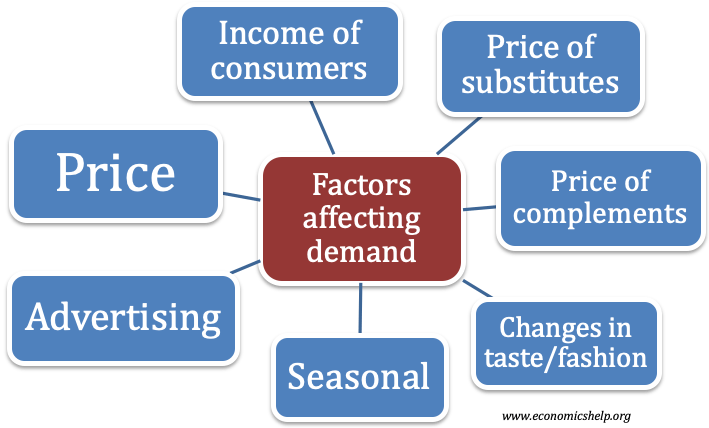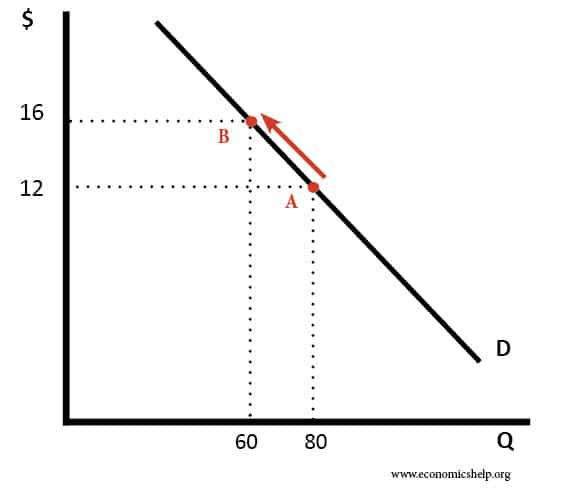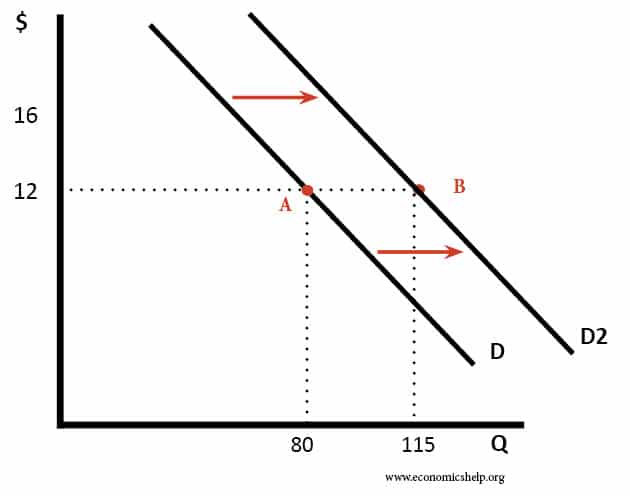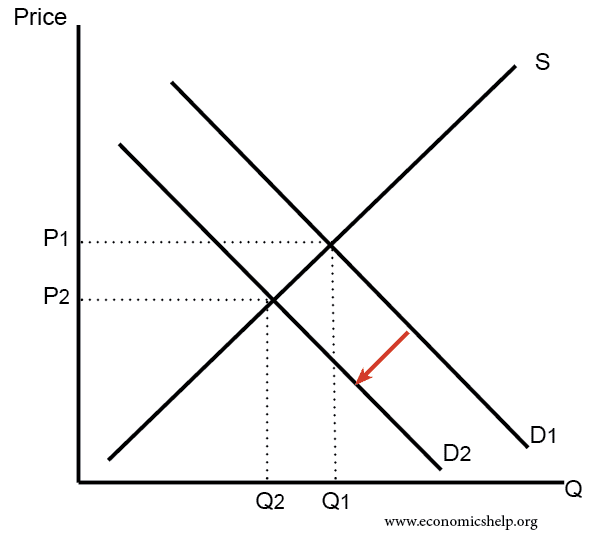The demand for a good depends on several factors, such as price of the good, perceived quality, advertising, income, confidence of consumers and changes in taste and fashion.

We can look at either an individual demand curve or the total demand in the economy.
- The individual demand curve illustrates the price people are willing to pay for a particular quantity of a good.
- The market demand curve will be the sum of all individual demand curves. It shows the quantity of a good consumers plan to buy at different prices.
1. Change in price
A change in price causes a movement along the Demand Curve.

For example, if there is an increase in price from $12 to £16 then there will be a fall in demand from 80 to 60.
How important is price?
Some goods are more affected by price than others.
- If petrol increases in price, because it is a necessity, there is only a small fall in demand (we say it is inelastic demand).
- If Volvic water increases in price, there will be a significant fall in demand because people buy cheaper substitutes (demand is elastic)
Shifts in the demand curve
This occurs when, even at the same price, consumers are willing to buy a higher (or lower) quantity of goods. This will occur if there is a shift in the conditions of demand.

Even at the same price of $12, more is demanded.
Factors which can shift the demand curve
A shift to the right in the demand curve can occur for a number of reasons:
- Income. An increase in disposable income enabling consumers to be able to afford more goods. Higher income could occur for a variety of reasons, such as higher wages and lower taxes.
- Credit facilities. If it is easier and cheaper to borrow, this may encourage consumers to buy expensive items on credit, for example, cars and foreign holidays.
- Quality. An increase in the quality of the good e.g. better quality digital cameras encourages people to buy one.
- Advertising can increase brand loyalty to goods and increase demand. For example, higher spending on advertising by Coca Cola has increased global sales.
- Substitutes. An increase in the price of substitutes, e.g. if the price of Samsung mobile phones increases, this will increase the demand for Apple iPhones – a major substitute for the Samsung.
- Complements. A fall in the price of complements will increase demand. E.g. a lower price of Play Station 2 will increase the demand for compatible Play Station games.
- Weather: In cold weather, there will be increased demand for fuel and warm weather clothes.
- Expectations of future price increases. A commodity like gold may be bought due to speculative reasons; if you think it might go up in the future, you will buy now.
- Change in circumstances. The Covid lockdown of 2020/21 led to a significant fall in demand for leisure and going out to the cinema, but it led to a boom in demand for electrical goods, like TVs and Netflix subscriptions.
- Economic cycle. In a recession, people will cut back on spending, even if their income remains steady. This is because they fear the possibility of losing job, so they will take risk averse approach and reduce spending. Similarly in an economic boom, confidence will be high and incomes rising – causing more demand
- Wealth-effect. If households experience an increase in their wealth (e.g. house prices rise), then they will be more willing to spend. This is because they can re-mortgage their house to get equity withdrawal and/or they will feel more confidence because they own more assets.
Fall in demand

A fall in demand could occur due to lower disposable income or decline in the popularity of the good.
Evaluation
- For some luxury goods, income will be an important determinant of demand. e.g. if your income increased you would buy more restaurant meals, but probably not more salt.
- Advertising is important for goods in which branding is important, e.g. soft drinks but not for bananas.
Video on demand
Other types of demand
- Effective demand: This occurs when a consumers desire to buy a good can be backed up by his ability to afford it.
- Derived demand: This occurs when a good or factor of production such as labour is demanded for another reason
- A Giffen good is a good where an increase in price of a basic item leads to an increase in demand, because very poor people cannot afford any other luxury goods.
- An ostentatious good, is a good where an increase in price leads to an increase in demand because people believe it is now better.
- Composite demand – A good which is demanded for multiple different uses
- Joint demand – goods bought together e.g. printer and printer ink.
Related pages
